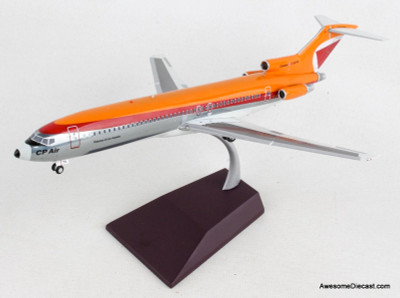This model can be displayed in flight on the stand or with landing gear down on the ground
The Boeing 717 is an American five-abreast single-aisle airliner produced by Boeing Commercial Airplanes. The twin-engine airliner was developed for the 100-seat market and originally marketed by McDonnell Douglas as the MD-95. It was a shortened derivative of the company's successful airliner, the MD-80, and thus the third generation of the DC-9 family. Capable of seating up to 134 passengers, the 717 has a design range of 2,060 nautical miles (3,820 km). It is powered by two Rolls-Royce BR715 turbofan engines mounted at the rear of the fuselage.
The first order for the airliner was placed with McDonnell Douglas in October 1995 by ValuJet Airlines (later AirTran Airways). With McDonnell Douglas and Boeing merging in 1997 prior to production, the airliner entered service in 1999 as the Boeing 717. Production of the type ceased in May 2006 after 155 were delivered. As of June 2022, 103 Boeing 717 airliners remain in service and have recorded zero fatalities and no hull losses
Trans World Airlines (TWA) was a major American airline which operated from 1930 until 2001. It was formed as Transcontinental & Western Air to operate a route from New York City to Los Angeles via St. Louis, Kansas City, and other stops, with Ford Trimotors. With American, United, and Eastern, it was one of the "Big Four" domestic airlines in the United States formed by the Spoils Conference of 1930.
Howard Hughes acquired control of TWA in 1939, and after World War II led the expansion of the airline to serve Europe, the Middle East, and Asia, making TWA a second unofficial flag carrier of the United States after Pan Am. Hughes gave up control in the 1960s, and the new management of TWA acquired Hilton International and Century 21 in an attempt to diversify the company's business.
As the Airline Deregulation Act of 1978 led to a wave of airline failures, start-ups, and takeovers in the United States, TWA was spun off from its holding company in 1984. Carl Icahn acquired control of TWA and took the company private in a leveraged buyout in 1988. TWA became saddled with debt, sold its London routes, underwent Chapter 11 restructuring in 1992 and 1995, and was further stressed by the explosion of TWA Flight 800 in 1996.
TWA was headquartered at one time in Kansas City, Missouri, and planned to make Kansas City International Airport its main domestic and international hub, but abandoned this plan in the 1970s. The airline later developed its largest hub at St. Louis Lambert International Airport. Its main transatlantic hub was the TWA Flight Center at John F. Kennedy International Airport in New York City, an architectural icon designed by Eero Saarinen, and completed in 1962.
In January 2001, TWA filed for a third and final bankruptcy and was acquired by American Airlines. American laid off many former TWA employees in the wake of the September 11, 2001 attacks. TWA continued to exist as an LLC under American Airlines until July 1, 2003. American Airlines downsized the St. Louis hub later that year.














